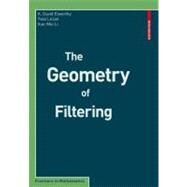- ISBN: 9783034601757 | 3034601751
- Cover: Paperback
- Copyright: 12/30/2010
The geometry which is the topic of this book is that determined by a map of one space N onto another, M, mapping a diffusion process, or operator, on N to one on M.Filtering theory is the science of obtaining or estimating information about a system from partial and possibly flawed observations of it. The system itself may be random, and the flaws in the observations can be caused by additional noise. In this volume the randomness and noises will be of Gaussian white noise type so that the system can be modelled by a diffusion process; that is it evolves continuously in time in a Markovian way, the future evolution depending only on the present situation.This is the standard situation of systems governed by Ito type stochastic differential equations. The state space will be the smooth manifold, N, possibly infinite dimensional, and the "observations" will be obtained by a smooth map onto another manifold, N, say. We emphasise that the geometry is important even when both manifolds are Euclidean spaces. This can also be viewed from a purely partial differential equations viewpoint as one smooth second order elliptic partial differential operator lying above another, both with no zero order term.We consider the geometry of this situation with special emphasis on situations of geometric, stochastic analytic, or filtering interest. The most well studied case is of one Brownian motion being mapped to another with a consequent skew product decomposition (or equivalently the case of Riemannian submersions). This sort of decomposition is generalised and a key to the rest of the book. It is used to study in particular, classical filtering, (semi-)connections determined by stochastic flows, and generalised Weitzenbock formulae.






